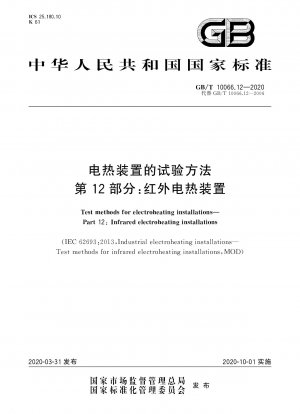GB/T 10066.12-2020
Test methods for electroheating installations—Part 12:Infrared electroheating installations (English Version)
- Standard No.
- GB/T 10066.12-2020
- Language
- Chinese, Available in English version
- Release Date
- 2020
- Published By
- 国家市场监督管理总局、中国国家标准化管理委员会
- Latest
- GB/T 10066.12-2020
- Replace
- GB/T 10066.12-2006
- Scope
- This part of GB/T10066 specifies the test procedures, conditions and methods for industrial infrared electric heating devices. Based on these contents, their main parameters and main operating characteristics are determined. The scope of this section is limited to: infrared emitters with a maximum spectral radiation wavelength above 780 nm in air or vacuum, and which emit a broad-band continuous spectrum through thermal radiation or high-voltage arcs. In industrial infrared electric heating devices, infrared radiation is usually generated by infrared emitters, and infrared radiation significantly exceeds thermal convection and thermal conduction as a heat transfer method to transfer energy to the workpiece. GB/T5959.1-2019 defines infrared as optical radiation with a frequency range between approximately 400THz and 300GHz. The corresponding wavelength range in vacuum is 780nm~1mm. Industrial infrared heating usually uses infrared sources with rated temperatures between 500°C and 3000°C. The radiation emitted from these infrared sources is mainly in the wavelength range of 780nm to 10μm. Devices within the scope of this section typically utilize the Joule effect to convert electrical energy from one or more infrared sources into infrared radiation and emit it to the workpiece. The following infrared emitters are particularly special: ——Tubular, plate or other-shaped ceramic thermal infrared emitters with resistive elements inside; ——Infrared quartz glass tubes or halogen lamp emitters using high-temperature filaments as heat sources; ——— Non-insulating elements made of molybdenum disilicide, silicon carbide or similar materials; ——Resistive metal heating elements made of nickel-based alloys or iron-chromium-aluminum alloys; ——Broad-spectrum arc lamps. This section does not apply to: ——- Infrared devices using lasers or light-emitting diodes (LEDs) as the main radiation source (GB/T20145-2006[9], GB7247.1-2012[6] and IEC/TR60825-9:1999 [7] Applicable to such devices); ——Public electrical appliances; ——Laboratory electrical appliances (IEC61010-1:2010 [8] applicable to such appliances); ——Resistance heating bare wires, electric heating Electric heating devices with tubes or electric heating rods as heating elements and in which infrared radiation is not a dominant side effect in the intended application are stipulated in GB5959.4-2008[5]; ——The nominal total power of all infrared emitters is less than 250W Infrared heating equipment; ——handheld infrared equipment. The purpose of these tests is to enable a fair comparison of the performance of devices of the same type. Tests related to the safety of the device are specified in GB/T5959.12-2020. Tests related to the performance of infrared electrothermal emitters are specified in IEC62798:2014[11]. Therefore, this section applies to ovens or furnaces with resistive heating elements within its scope.
GB/T 10066.12-2020 Referenced Document
- GB/T 5959.1-2019 Safety in installations for electroheating and electromagnetic processing—Part 1: General requirements
- GB/T 5959.12-2020 Safety in installations for electroheating and electromagnetic processing—Part 12: Particular requirements for infrared electroheating
GB/T 10066.12-2020 history
- 2020 GB/T 10066.12-2020 Test methods for electroheating installations—Part 12:Infrared electroheating installations
- 2006 GB/T 10066.12-2006 Test methods for electroheat installations.Part 12:Infrared heating installations

GB/T 10066.12-2020 -All Parts
GB/T 10066.1-2019 Test methods for electroheating and electromagnetic processing installations—Part 1: General
GB/T 10066.10-2005 Test methods for electroheat installtions Part 10:Direct arc furnaces
GB/T 10066.11-2016 Test methods for electroheat installations.Part 11:Submerged-arc furnaces
GB/T 10066.12-2020 Test methods for electroheating installations—Part 12:Infrared electroheating installations
GB/T 10066.2-2019 Test methods for electroheating and electromagnetic processing installations—Part 2: Direct arc furnaces
GB/T 10066.3-2014 Test methods for electroheat installations.Part 3: Induction channel and induction crucible furnaces
GB/T 10066.31-2007 Test methods for electroheat installations.Part 31: High-frequency induction heating installation.Test methods for the determination of power output of the generator
GB/T 10066.32-2021 Test methods for electroheating and electromagnetic processing installations—Part 32:Induction through-heating installations
GB/T 10066.4-2004 Test methods for electroheat installations Part 4:Indirect resistance furnaces
GB/T 10066.5-2014 Test methods for electroheat installations.Part 5:Plasma equipment for electroheat and electrochemical applications
GB/T 10066.6-2018 Test methods for electroheating and electromagnetic processing installations—Part 6:Test methods for the determination of power output of industrial microwave heating installations
GB/T 10066.7-2009 Test methods for electroheat installations.Part 7:Electroheating installation with electron guns
GB/T 10066.8-2006 Test methods for electroheat installations.Part 8:Electroslag remelting furnaces
GB/T 10066.9-2008 Test methods for electroheat installations.Part 9:The determination of power output for high-frequency dielectric heating installation